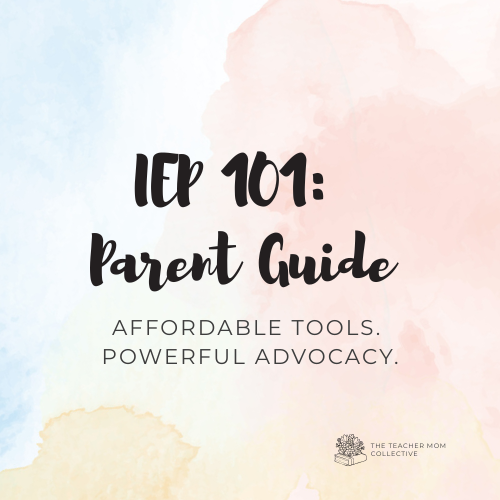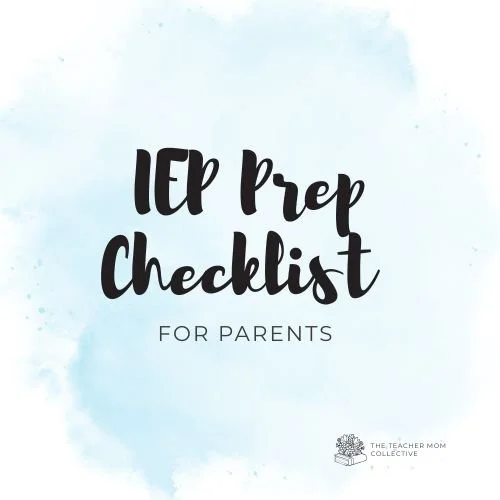5 Mistakes Parents Make in IEP Meetings and How to Avoid Them
If you have ever walked out of an IEP meeting feeling overwhelmed, unheard, or like you forgot half of what you wanted to say, you are not alone.
As an ESE teacher, I have sat in more IEP meetings than I can count. I have seen so many parents who desperately want to be involved and advocate for their child, but they just don’t know what questions to ask or what they should say. Many parents are not familiar with special education or the IEP process, and because of that, they sometimes feel like the odd one out at the table. But the truth is, no one knows or loves their child more than the parents do, and the parent input is one of the most valuable pieces of the whole process. That is exactly why I created the IEP 101: Parent Guide, to give parents the knowledge and confidence to walk into meetings as active, empowered members of the team rather than silent bystanders.
The good news is that with preparation and a few insider strategies, you can avoid the most common pitfalls parents face and walk into the room feeling confident and in control. Let’s break down five mistakes parents often make in IEP meetings and what to do instead.
Mistake 1: Going in Without a Clear Plan
The pitfall: Many parents walk into IEP meetings hoping they will just remember everything they want to bring up. In the fast-paced environment of a team meeting, it is easy to lose track of your priorities.
The fix: Write everything down. Before the meeting, make a list of your child’s strengths, needs, progress, and specific concerns. Bring copies of private evaluations, notes from teachers, or even your own observations at home. A written plan ensures you will not leave without addressing what matters most.
Resource: My free IEP Prep Checklist walks you step by step through exactly what to gather before your next meeting so nothing slips through the cracks.
Mistake 2: Focusing Only on Weaknesses
The pitfall: Parents naturally want to advocate for areas where their child struggles — but sometimes that means the conversation becomes all about deficits. And that’s only half the story.
The fix: Always start with strengths. Share what lights them up! Share what motivates your child, what interests them, and what strategies already work at home. This builds a positive tone for the meeting and helps the team think about how to build on your child’s unique abilities, not just remediate their struggles.
Teacher tip: When you bring up concerns, connect them to strengths. For example, “He loves music. Can we use songs to support his reading goals?” This shifts the discussion from problems to possibilities.
Mistake 3: Accepting Vague Goals or Services
The pitfall: Sometimes IEP goals or services are written in vague language such as “will improve reading skills” or “receive support as needed.” These sound nice, but they are not measurable, and without clear benchmarks it is hard to hold the school accountable.
The fix: Ask for specific, measurable goals and services. Instead of “improve reading,” you want something like:
“By May, the student will read 40 sight words with 80 % accuracy in three out of four trials.”
That’s concrete. You can track it. And you can hold the team accountable.
Ask questions like:
How will this goal be measured?
Who’s responsible for progress monitoring?
How often will we get updates?
Resource: I break down how to recognize strong versus weak goals and how to request changes in my IEP 101: Parent Guide. It is written to help you feel confident in reviewing your child’s IEP.
Mistake 4: Not Asking Questions
The pitfall: Acronyms start flying, people talk fast, and you don’t want to interrupt, so you nod along, hoping it will all make sense later. But by the time you get home, you’re thinking, “Wait… what did we just agree to?”
The fix: Ask questions — lots of them. And do not be afraid to pause the meeting until you get clear answers.
If something sounds unclear, say:
“Can you explain that in plain language?”
“Can you give me an example of how that support will look day-to-day?”
Teacher tip: Bring a notepad and write down questions as you think of them. Then check them off during the meeting so you know they are answered.
Mistake 5: Forgetting That You Can Follow Up
The pitfall: Parents often feel like the IEP meeting is their one shot to get everything right. But IEPs are living documents, and you do not have to wait a full year to make changes.
The fix: If something is not working, or if new concerns arise, you can request another meeting at any time. You can also follow up with emails to clarify, request updates, or document agreements in writing. Advocacy is ongoing, not one and done.
Resource: The free IEP Prep Checklist I mentioned earlier also includes tips for after the meeting so you know exactly how to document and follow up effectively.
Final Thoughts
IEP meetings can feel intimidating (even for teachers!), but here’s the thing: you know your child best. When you come in with a plan, celebrate strengths, push for clarity, ask questions, and follow up, you show the team that you are not only involved, you are a partner in the process.
Mistakes happen. That’s okay. Every meeting is a learning experience, and the fact that you’re reading this means you’re already doing something right: showing up, learning, and advocating with love.
Free and Paid Resources for Parents
Free Resource: Download my IEP Prep Checklist to get organized before your next meeting. It is the same tool I use to guide parents I work with, and it makes the process so much less overwhelming.
Paid Resource ($35): If you are ready to dive deeper, my IEP 101: Parent Guide breaks everything down step by step, from decoding the IEP document to understanding your rights, timelines, and how to ask for changes. It is like having a teacher-parent advocate in your back pocket.
When you walk into an IEP meeting prepared, confident, and informed, you do not just make the process easier. You open more doors for your child.



